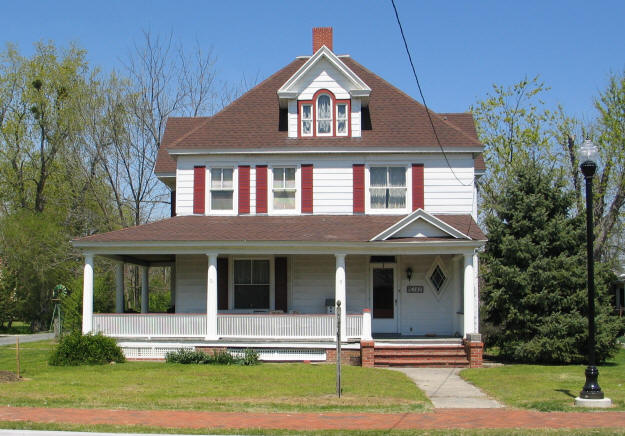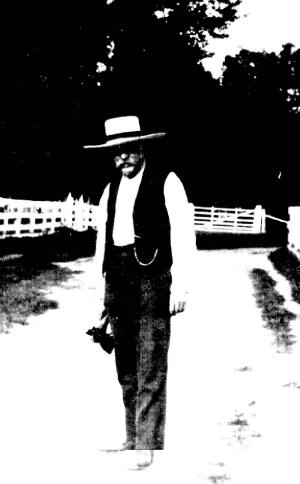East New Market
Property Reports
102 Railroad Avenue
Lida M. Smith House
Residence of B.W. Sherman, Louis L. Smith House

From the Maryland Historical Trust - State Historic Sites Inventory Form - 1985
The Louis L. Smith house stands on the north side of Railroad Avenue directly east of the mid eighteenth-century dwelling, "Buckland." The two-and-a- half story frame dwelling faces south. Built around 1904, the two-and-a-half story frame house is supported by a common bond brick foundation and is sheathed with a uniform layer of aluminum siding.
The steeply pitched pyramidal roof is covered with asphalt shingles. The south (main) facade is an asymmetrical three-bay elevation with an east bay entrance and a flanking two-over-one sash window. The front door is topped by a single-pane transom. Immediately east of the entrance is a diamond- shaped colored glass window. The first floor is completely sheltered by a Tuscan columned porch. A small gable marks the entrance bay, and a handrail stretches between the posts.
The second floor is lighted by three unevenly spaced two- over-one sash windows. Louvered aluminum shutters flank the windows. Centered on the south slope of the roof is a large gabled dormer with a three- part Palladian-style window. Rising through the center of the house is a narrow brick chimney. The east elevation is distinguished by a projecting two-story gabled bay pavilion with two-over-one sash windows on the first and second floor along with an arched single-pane sash attic light. The west elevation is marked by a projecting two-story, three-sided gabled pavilion with two-over-one sash on each floor and an arched single-pane attic sash window. The front porch wraps around to the west side and provides access to the side entrance. A glazed side door is topped by a single-pane transom. The north (rear) elevation is an asymmetrical facade as well with a projecting two-story gabled bay and flanking single story shed roofed enclosed porches. The interior was unseen.
The Louis L. Smith house is a large two-and-a-half story early twentieth-century frame house that stands on the north side of Railroad Avenue in a Line of contemporary dwellings. The pyramidal roofed structure is similar to several other nearby houses with a wraparound Tuscan columned porch, colored glass stair windows, and large gabled dormers. Louis L. Smith is credited with erecting this house around 1904 after the lot of ground facing Railroad Avenue was purchased in September of 1903 by Lida M. Smith.

Notes from Kirk Hurley
The deed into William M. and John W. Fletcher (sons of Major S. and Wilhelmina King Fletcher) was as trustees of their parents’ property for the benefit of creditors. This was an early form of bankruptcy at the state level and was a precursor to the modern deed of trust which is not used in the same way today.
The key players appear to have been John and his wife Sarah. Their names appear most often as the lots are “developed”. (John later became the Registrar for the Office of the Register of Wills of Dorchester County.) What was “developed” in what was known as “M.S. Fletcher Lots” (or what I term the Major S. Fletcher subdivision) which were a series of lots most measuring 30 feet by 150 feet. Most lots were sold in larger groups constituting the configuration we see today.
Thomas Quincy (Q.) Leckie was a local surveyor and ascribed the names to the Streets in the “Fletcher Subdivision”. “Leckie Street ” and “Bramble Street” are fairly self explanatory but “Cleveland Street” was named for President Grover Cleveland first elected in 1884. All of these lots were part of the farm bought by Major S. and Wilhelmina K. Fletcher from William Christopher. For reference see the deed dated April 1, 1867 and recorded at F.J.H. 7 / 32.

In an interview some years ago with “Miss Bootsie” Smith I learned some
things about her including some things that as a young boy in the town I
would not have known nor would have likely to have been discussed openly
in front of me. Miss Bootsie’s maiden name was Corkran. I
have some recollections of her mother who lived with her until her death
at the age of 102. Among her brothers was William O. Corkran who
was a close friend, along with his wife Hazel, to my parents.
Miss Bootsie was a language teacher and my father’s older brother
Russell was in one of her first classes, she being barely older than he.
She taught at East New Market High School until its merger with other
area small town High Schools to form North Dorchester High School.
The languages taught were Latin and French and her students included my
older brother and sister and me. She retired at the end of my Junior
year in high school in 1969.
In the course of the interview I discovered that she and Mr. Hamill (T.
Hamill Smith, Sr.) had once owned the house that was then occupied by
Medora and Lee Grey. She and Medora had both been on faculty to
together at the East New Market School. They had clay tennis
courts in the back of the house on which Medora and Evelyn her sister
had played tennis with them. They had played cards and drank lemonade on
the veranda.
While their relationship had been collegial it had not been
necessarily congenial. When Mr. Hamill lost the house in
foreclosure it was during the depression. He had been working at
the local bank and lost his job due to the embezzlement of funds by his
brother Marion from the same bank but at another branch in a neighboring
town.
While they struggled, they were unable to hold onto the house. And
when the house went to auction in foreclosure Evelyn and her husband had
bought it. Medora and her husband lived there and Bootsie and
Hamill had to find a new home and start over. She felt that they
had taken advantage of their misfortune to profit for themselves.